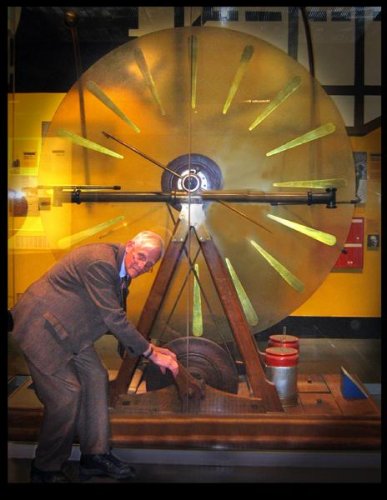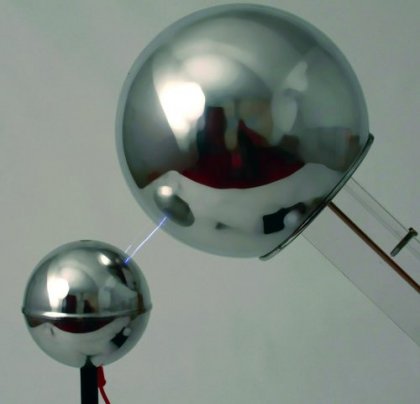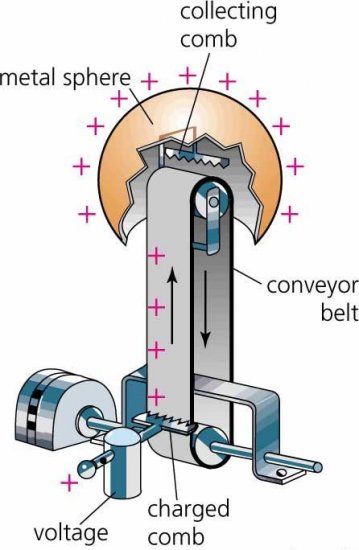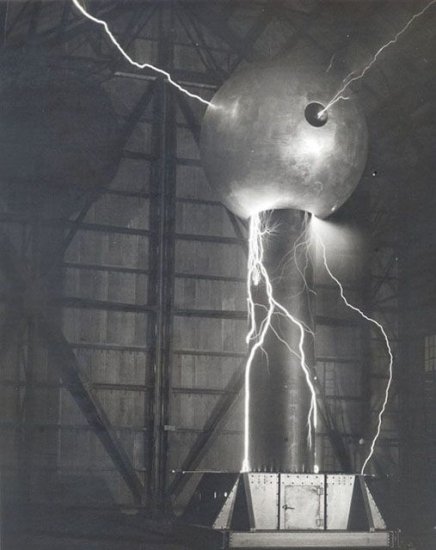Electrostatic generators — device, principle of operation and application
Electric charge — the phenomenon when two opposite charges of equal magnitude cancel. If two bodies, strongly charged with an opposite electric charge, are at a close distance from each other, then a spark jumps between them and a short popping sound is heard.
The force of action of an electrically charged body on another, whose charge is taken as a unit, is called potential. The potential difference is the voltage.
First ways to get electrical charges and electrostatic fields consist of the friction of various materials (fur, wool, silk, leather and other materials against glass, resin, rubber etc.). At the same time, the voltages and charges were extremely small. Induction and accumulation of charges by mechanical transfer made possible a slight increase in the resulting voltages.
Subsequently, in order to obtain high voltages, continuously operating machines with rotating discs based on the principle of electrostatic guidance (induction) were created.However, these machines did not make it possible to obtain high power and found application mainly as devices in the physics offices of educational institutions.
Electrification of bodies and electrostatic induction
The message to the body of electric charges is called electrification… Described in the article Electrification of bodies and interaction of charges the process of formation of positive and negative ions gives an idea of the process of electrification of bodies: it consists in the transfer of electrons from one body to another.
Thus the electrical charge of the body is determined by the excess or deficiency in the body. electrons… It is possible to electrify a body in various ways, of which friction, contact, direction, transfer of charge are technical.

The reverse process — restoration of the body's neutral state (neutralization) — consists in giving it a missing number of electrons or removing an excess of them from it.
During electrification by friction, if no additional charges are communicated to either of the contacting bodies from the outside, both bodies are charged with the same amount of electricity of different signs. When bodies are connected, their charges are completely neutralized.
In this way, charges are not created or destroyed, but only transferred from one body to another. This convinces us of the existence of the law of conservation of electric charges, for example law of conservation of energy.
Static electricity — electric charge at rest. Occurs as a result of friction between two non-conductors or a non-conductor and metal (e.g. motor drive belts), but not necessarily solid bodies.
Static electricity can also arise from the friction of certain liquids or gases. People with very dry skin accumulate electrical charges. During movement (rubbing of the fibers on the skin), a significant static electric charge occurs in the fabric, the fabric adheres to the body and prevents movement.
Static electricity becomes dangerous in flammable and explosive environments where a single spark can ignite an entire mass. In this case, it is necessary to immediately release the static charge into the ground or air by means of some metallic device whose conductivity can be increased by humidification or irradiation.
Electrostatic induction — the appearance of electric charges on the wire under the influence of other charges located near the wire (body electrification at a distance).
Under the action of an external charge, a charge is induced (arises) at the nearest end of the conductor, the sign of which is opposite to the sign of the charge acting from the outside, and at the far end of the conductor, a charge of the same sign. In this case, both inductive charges are equal in magnitude, that is, the induction causes only a separation of charges on the wire, but does not change the total charge on the wire (since the sum of the induced charges is zero).
The magnitude of the induced charges and their location are determined by the condition that there should be no electrostatic field inside the conductor. Therefore, the induced charges are positioned so that the electric field they create simply destroys the field inside the wire that is created by the inductive charge.
An example of electrostatic induction: in an uncharged electroscope both electric charges, positive and negative, are in equal amounts and therefore the electroscope is not electrified.
If a glass rod with a positive charge approaches it, then the free electrons will simultaneously be attracted to it and the positive charge of the electroscope simultaneously repelled.
The negative charge is concentrated closer to the glass rod, is connected to it, while the positive charge is repelled and is therefore located on the back side of the electroscope — it is free.
The electroscope is now electrified. However, this condition is not long-lasting. It is worth removing the glass rod, since the separation of the charge into positive and negative is violated, the neutral state of the electroscope is restored and its leaves return to their original position.
Electroscope — a device with which it is possible to determine with what charge the body is electrified. It consists of a metal rod with a ball or plate at the top end and two free-hanging metal sheets at the bottom. The operation of the electroscope is based on the principle: bodies of the same name repel each other (See — The principle of operation of the electroscope).
Electrostatic induction is one of the causes of lightning in nature, — the most powerful and dangerous manifestation of atmospheric static electricity.
Lightning It is a discharge of atmospheric electricity between individual parts of the cloud, individual clouds, the cloud and the Earth, from the Earth to the cloud. In other words, lightning can be defined as an electric current of short duration, an electric spark that equalizes the electric potentials.
35 Frequently Asked Questions About Thunderstorms and Lightning
Van de Graaf electrostatic generator
For scientific and technical purposes (for example, in nuclear physics, radiobiology, X-ray therapy, materials testing, flaw detection, etc.), devices that can generate voltages of several million volts are needed.
Such devices are technically advanced electrostatic generators with high direct voltage. The most famous of them is the Van de Graaf generator, created in 1829 by an American physicist Robert van de Graaff (1901 - 1967).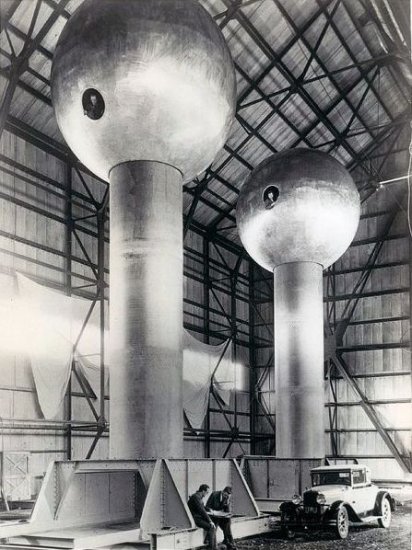
Van de Graaf generator (1933) with a voltage of 7 megavolts
The generator is a metal hollow ball mounted on a tall hollow column of insulating material. The dimensions of the ball and the height of the column are determined by the limit of the required voltage of the generator (for example, for a generator with a voltage of 5 MV, the diameter of the ball reaches 5 m). An endless belt of insulating material (silk, rubber) moves inside the column, which serves as a conveyor for transferring charges to the sphere.
As you move up, the strip runs at the bottom of the device past the brush connected to one pole of the source direct current voltage of about 10,000 V (a suitable rectifier can serve as this source). In designing his first electrostatic generators, Van de Graaf used the device with a vacuum tube.
Van de Graaff electrostatic generator device
From the tips of this brush, the charges flow down onto the belt, which carries them inside the ball, and through the second brush they pass to the outer surface of the ball.To improve the process of moving the uncharged part of the tape down, the charges of the opposite sign are transferred, with the help of brushes removed from the charged ball.
Due to electrostatic induction, a negative charge appears on the brush, which is carried by the discharge to the descending part of the belt. This charge is then transferred to the brush and grounded lower roller, through which it is discharged to the ground.
As the tape continues to move, the charge on the ball increases until it reaches a predetermined threshold value determined by the diameter of the ball and the distance from it to another electrode or to ground.
As the tape continues to move, the charge on the ball increases until it reaches a predetermined threshold value determined by the diameter of the ball and the distance from it to another electrode or to ground.
To increase the voltage, two such devices are installed, in which the balls receive charges of opposite signs. So, for example, to obtain a voltage of 10 MV, two generators are used, charged with respect to the ground to +5 MV and -5 MV and installed at such a distance from each other that the possibility of breakdown at a voltage less than given Is Turned Off.
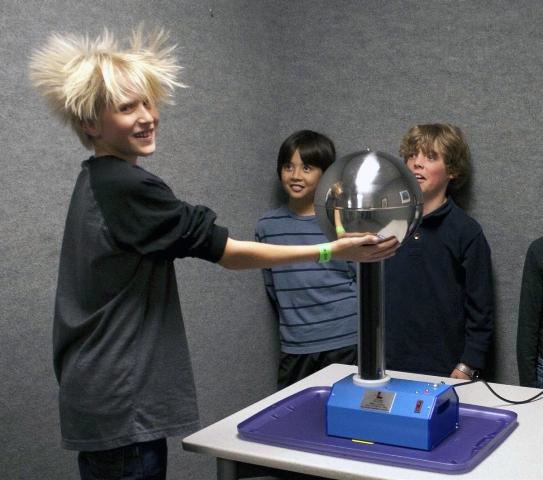
Currently, there are a large number of different models of electrostatic generators, including those that repeat the Van de Graaff design. They are used both for physical experiments and as an attraction for entertainment and action demonstrations. static electricity.
It is interesting: Triboelectric effect nanogenerator (TENG)

